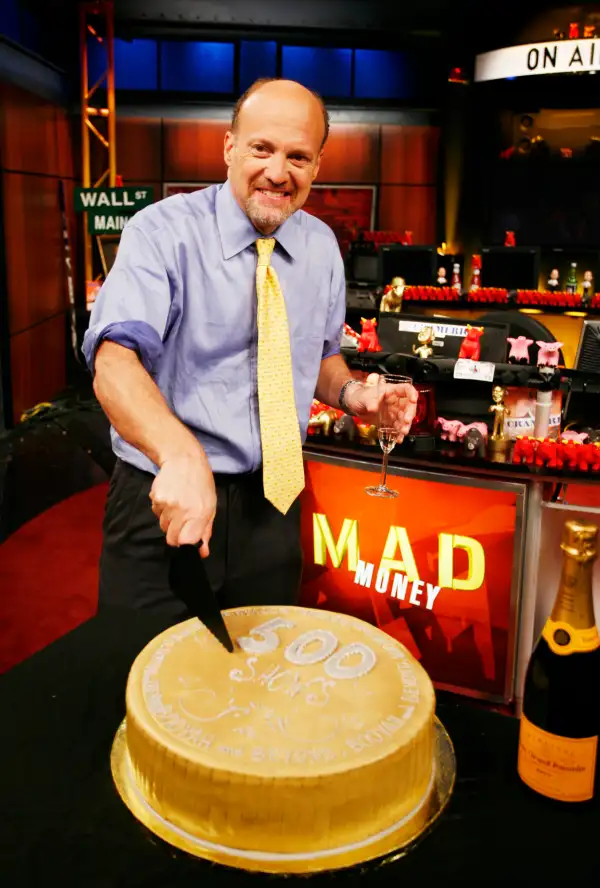How Watching TV Can Make You Poorer
Money is not a client of any investment adviser featured on this page. The information provided on this page is for educational purposes only and is not intended as investment advice. Money does not offer advisory services.

You cannot listen to the steady barrage of confident yet conflicting opinion on financial TV programs today without wondering which, if any of them, are getting it right. It’s been this way since the incomparable Louis Rukeyser launched the weekly PBS program Wall Street Week in 1970.
The pioneering cable station Financial News Network, which CNBC later bought, upped the ante in 1981 with daily money programming. That set the foundation for three decades of growth in the market for folks who could talk convincingly about the direction of stocks. This period made stars of analysts who often got it wrong—from Joe Granville and Robert Prechter in the 1980s to Henry Blodget and Jim Cramer in more recent times.
Yet as the voices of market gurus have grown louder and more numerous, the advice hasn’t got any better. The poor individual investor—stripped of his pension guarantees and wanting little more than to manage his 401(k) in a sound manner—has been left dizzy from the noise. This, at least, is the basic premise of Clash of the Financial Pundits, a book by financial commentators that takes aim at financial commentators.
The authors are former CNBC personality Jeff Macke and current contributor Joshua M. Brown, co-founder of Ritholtz Wealth Management. They write mostly in the voice of Macke, who during the depths of the financial crisis grew disillusioned with his role on Fast Money and disappeared—though not before an epic on-camera meltdown that can only be described as must-see TV. In some ways, this book reads like a cathartic undertaking meant to exorcise Macke’s demons. He is now host of the financial show Breakout, which appears on Yahoo Finance. I wonder if he realizes that by dredging up the memory of his public implosion five years ago more people will see it on YouTube than saw it live.
Clash is a stroll down memory lane for anyone that has been around the financial markets a while. It recounts bubbles past, starting with the South Sea Co. in the early 1700s when Sir Isaac Newton lost a fortune. The authors recount the rise and fall of “Calamity Joe” Granville, the spectacularly wrong Harry S. Dent, and the absurd Dow 36,000 prediction from journalist James K. Glassman and economist Kevin A. Hassett. Other names that pop up along the way include Ben Stein, Jim Rogers, Carl Icahn, James Altucher, Martin Zweig and more.
Brown and Macke give credit where it is due: Zweig’s real-time call of the 1987 crash on Wall Street Week, Cramer’s October 2008 sell-it-all message delivered on The Today Show, Blodget’s almost comical prediction in 1998 that Amazon.com would hit $400, which it did in just two months. But the whole point is to also note their miscalls and downfalls. Blodget, for example, was banned from the industry for life in 2002 after privately advising certain investors to sell stocks that he was publicly bullish on. Cramer took a beating on Jon Stewart’s Daily Show for being bullish on the soon-to-collapse Bear Stearns.
Being right and wrong is all part of the forecasting business, the authors point out, which is why it’s foolish to invest solely on one pundit’s view at any given moment. “At a certain point, the folly of forecasting becomes obvious,” the authors write. “It is at the dawning of this realization that we begin to grow as investors.”
As a young financial writer at USA Today, I watched the market for market punditry explode in the 1980s and 1990s. I was the first mainstream reporter to cover the annual “10 Surprises” list that helped elevate Morgan Stanley’s Byron Wien. Brown and Macke note that Wien’s innovation, which other forecasters soon picked up on, was a clever way to make a predication that could easily be dismissed if it did not come true. After all, who could be surprised if a surprise didn’t happen?
I worked next to Dan Dorfman, possibly journalism’s first $1 million investing columnist. In the 1980s, Dorfman wrote three times a week for USA Today and was on TV at least that often. His comments routinely moved stock prices and inspired other writers to try their hand at the market-moving game: Gene Marcial at Business Week, John Crudele at the New York Post, Herb Greenberg at the San Francisco Chronicle, to name three.
But Dorfman, who is not mentioned in Clash, had all but cornered this market. Ultimately, he got spread too thin and just couldn’t sustain the pressure to keep moving stocks. He was thought to be tied to a stock promoter and lost his job in 1996 when he refused to disclose his sources to his editor. (Full disclosure: Dorfman was working for Money magazine at the time.) At one point, venerable Coca-Cola responded to a Dorfman report with this statement: “Dan Dorfman does not have a clue.”
I’ve had my own brushes with TV punditry and seen firsthand how bookers, under pressure to get a warm body on camera, often don’t understand the topic to be discussed. They just want someone out there who will have an opinion and be entertaining. Once a booker asked me to go on air and talk about CEO pay. I had spent a week researching the subject and written a column about it. I was ready. On air, the host introduced the topic as Wall Street pay—which is a very different subject. I had almost nothing to contribute and was never invited back.
Macke and Brown explore this theme throughout and conclude that a successful pundit’s key attribute is the willingness to speak confidently on any topic, whether or not they understand it. Writing about Granville, whose “early warning” calls moved the market in the 1980s, they note that what he “had lacked in breadth and depth, he made up for with sheer personality and moxie. He had figured out the secret to all punditry, market or otherwise: certitude.”
The question underlying all of this is simple: Should you believe any financial forecaster and adjust your investments accordingly? The authors say no. They cite a 2005 study that looked at 27,000 forecasts by hundreds of experts over 15 years and concluded, “The experts’ forecasts were no more accurate than those of dart-throwing chimpanzees.”
That doesn’t mean expert opinion has no value. But the value is in the experts’ rationale and supporting arguments and how those jibe with your own considered view—not in blind loyalty to their advice. Key questions to ask include:
- Who are the experts and what do they get for having an opinion?
- Is their time frame the same as yours?
- How many investment ideas do they generate each day or week? Is that realistic?
- Why am I watching in the first place? Entertainment—or genuine need for this kind of information?
I didn’t expect to like this book. Pundits pontificating on the art of pontification feels light. Besides, even the pros know you should buy an index fund and head to the beach. The daily clatter is for traders and possibly ordinary people who just want to be entertained and try to understand how the market works.
But, like the punditry the authors explore, the material in Clash is entertaining. The book is built around engaging Q&A sessions and includes historical perspective that makes it useful in a big-picture kind of way. If you didn’t already know that the vast majority of talking heads are experts in name only, Clash will beat you over the head with examples until you are enlightened. As Cramer says in this book: “In the end it is just TV.”
More on how to invest:
- Where to Go for the Best Financial Advice
- Why Workers and Retirees Missed the Roaring Bull Market
- Why It's Never Too Late to Fix Your Finances
